From the March 2024 issue of Apollo. Preview and subscribe here.
In 1795, the German Romantic poet Friedrich von Matthisson visited the studio of the famous Swiss painter Angelica Kauffman in Rome. Kauffman, Matthisson reported, liked poetry to be read aloud to her while she worked. One morning, they heard a poem by Goethe, and Kauffman dropped her brush. ‘The entire being of the quiet, vestal-like, introverted woman became, as if through a violent electrical shock, elevated and shaken,’ he wrote. ‘Tears filled her eyes. Her silence was the silence of an enchanted Muse. Finally she broke out, in beautiful enthusiasm, with the words: “What a burning power of Sensibility!”’
To Matthisson, it was Kauffman, just as much as Goethe, who possessed the exemplary soulfulness they all admired, a power to move and be moved. During the later 18th century, he was one of a number of contemporary observers to represent her as an inspired ‘Muse’ of ‘Sensibility’. Active at the height of the cult of sentimentalism that dominated Europe until the 1790s, she was viewed as a kind of emotional superconductor, able to inspire and direct powerful currents of feeling. Matthisson read ‘burning’ sensibility on her body: it was visible in her altered ‘entire being’, the ‘violent’, ‘electrical’ way she responded, as if involuntarily, to Goethe’s language, her tears and her verbal outburst. Others saw it in her taste, the objects and people she surrounded herself with, and in the particular emotional atmosphere – contemplative, empathetic – she cultivated in her studio. Female painters of the period were aware that they were likely to meet with a more favourable response from the male-dominated art world if they produced tender and delicate scenes (coded as feminine) rather than grand or sublime ones. But Kauffman’s celebrated history paintings seemed extensions of her own astonishing sensibility. ‘Kauffman’s image and her art,’ Angela Rosenthal argues, ‘literally gave visual and expressive shape to the period itself. She was a proponent of sensibility, but also its embodiment.’
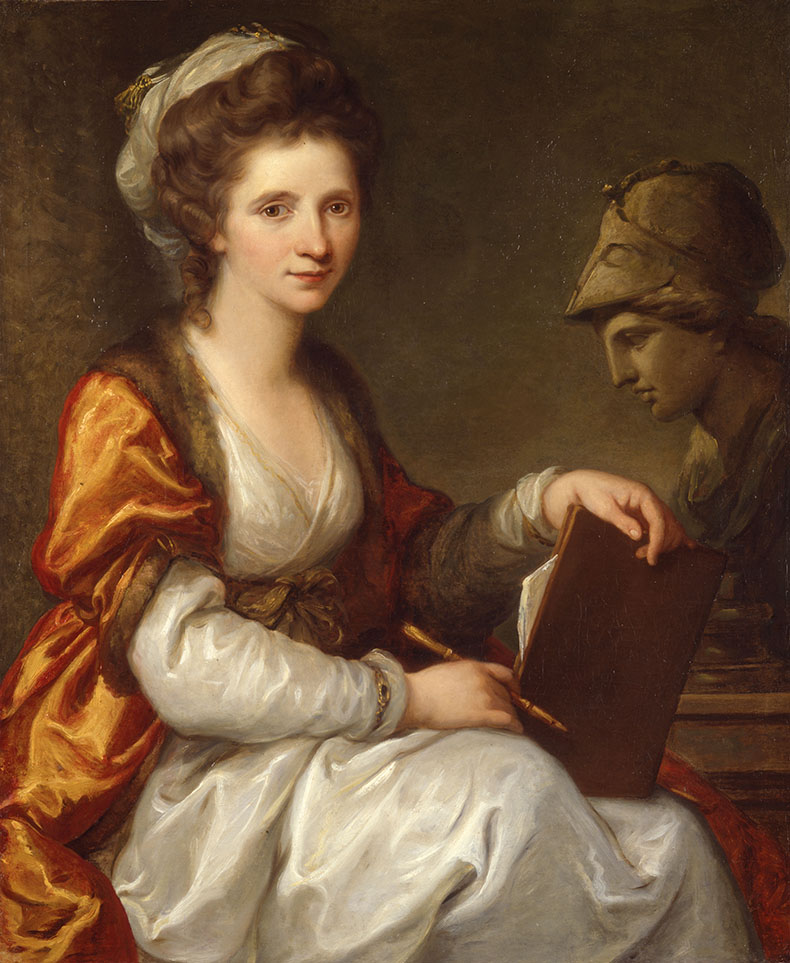
Self-Portrait with Bust of Minerva (c. 1780–84), Angelica Kauffman. Gottfried Keller Foundation (on loan to the Bündner Kunstmuseum, Chur)
Kauffman grew up in Switzerland and Austria, but honed her craft as a young woman by travelling with her father, also a painter, around Florence, Rome and Naples. In 1766, at the age of 24, she moved to England, setting up a studio in London. During her years there, she derived much of her income from portraiture, a lucrative artistic genre and one believed to be particularly suited to female painters. Women, it was argued, made good portraitists because of the ‘superior’ nature of their powers of sensibility. ‘Truly they have received from nature a fine instinct to read physiognomy and to convey and interpret the mobile gestural language of men,’ the German writer August von Kotzebue suggested in 1805. Female artists, adept at reading faces and bodies, could translate the physical ‘language’ of feeling into paint. By depicting significant gazes, gestures or blushes, they could show sensibility at work, make visible the private inclinations of a sitter’s head or heart. Kauffman produced pendant portraits of husbands and wives, in which complementary postures and the reflexive exchange of gazes told a story of intimacy. In her depictions of solo sitters, she liked to draw out a sense of inwardness, downplaying the external trappings of identity. Background landscapes, in her portraits of women, are suffused with feeling, made to represent interior worlds. In her portraits of male sitters, as Rosenthal observes, she imbued her subjects with a quality of tenderness, a refined sensibility, that reflected ideals of softened, civilised masculinity.
Kauffman’s real ambitions lay in history painting, held by contemporaries to be the highest artistic genre. Her first biographer, Giovanni Gherardo De Rossi, whom she knew later in life, claimed that by the age of 16 she had resolved to become a history painter. Travelling in Italy as a young woman, she studied the works of the Old Masters, sketched antique sculptures, and read history and poetry in several languages. From the beginning, she found inspiration for her narrative art in characters and subplots unexplored by her peers. One of her earliest large-format works was Penelope at Her Loom (1764), a single-figure history painted in Rome not long before she departed for England. The painting shows not Odysseus or Telemachus but Penelope, Odysseus’s wife, left behind in Ithaca, pausing her weaving to stare off mournfully into space.
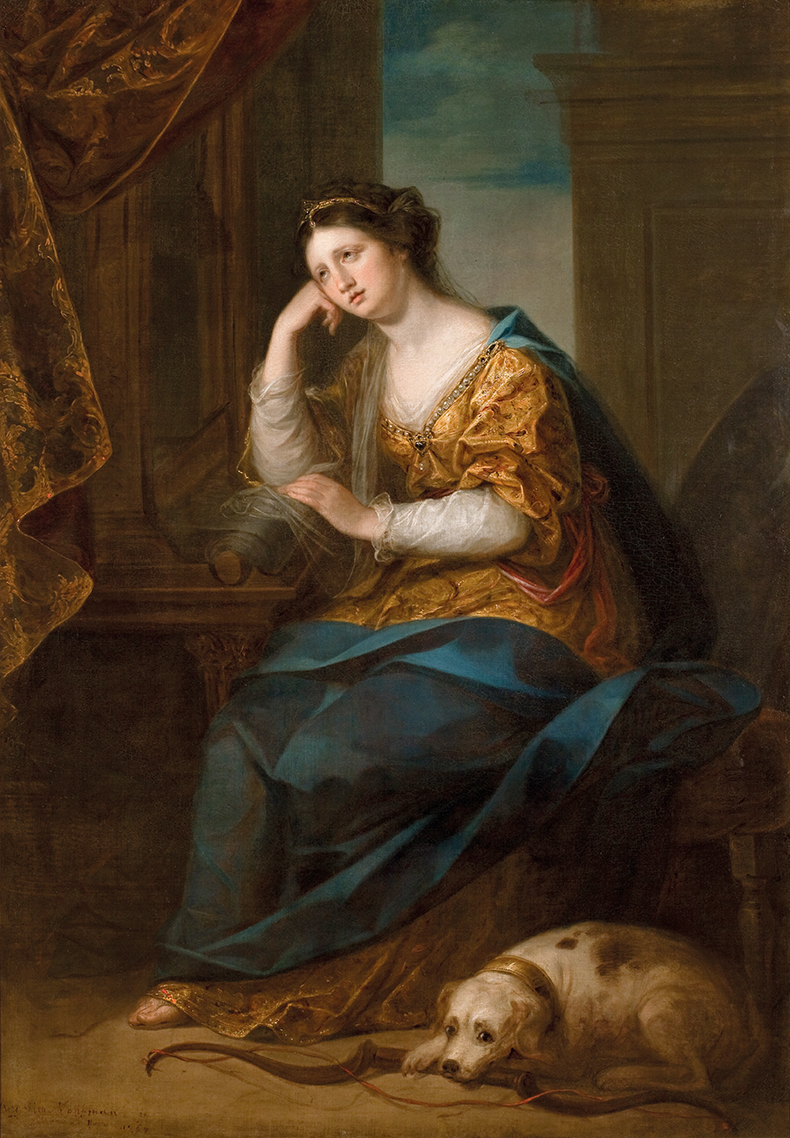
Penelope at her Loom (1764), Angelica Kauffman. Brighton & Hove Museums
Kauffman showed history canvases at the Royal Academy’s annual exhibitions regularly from 1769, the first year the opportunity arose. Every surviving narrative she exhibited has a woman in it, even those whose titles feature men. Unlike other history painters of the period, including fellow women artists such as Angélique Mongez, she consistently centred her narrative paintings around female subjects and stories. The many works she produced based on scenes from The Odyssey are remarkable for their omission of almost everything to do with Odysseus, focusing on scenes involving Penelope and her women. She was particularly interested in female figures on their own, either abandoned by a lover, or bereaved and grieving, or isolated through madness. Cleopatra Adorning the Tomb of Mark Antony (c. 1769–70), Ariadne Abandoned by Theseus (1774) and Calypso Abandoned by Odysseus (c. 1775–78) all show unhappy women robed in white, like pre-emptive ghosts.
Contemporary neoclassical artists, such as Kauffman’s acquaintances Gavin Hamilton and Benjamin West, produced busy, multi-figure scenes of sorrow or grief, in which personal feeling is made into a moralised public spectacle. Hamilton’s Andromache Bewailing the Death of Hector (1761) shows soldiers and women gesticulating and crowding around the central grouping of the lovers on the deathbed. In Kauffman’s histories sorrow typically happens as a private event, experienced as an intimate dialogue of feeling between subject and viewer.
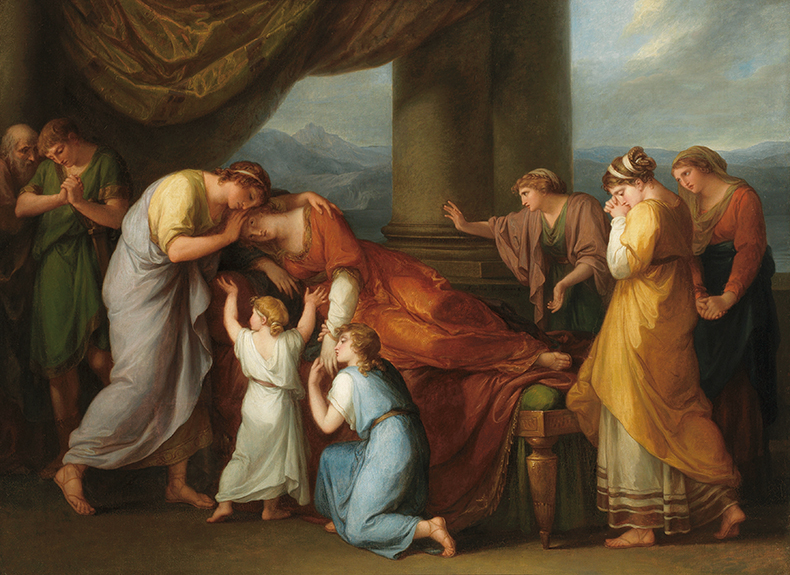
Death of Alcestis (1790), Angelica Kauffman. Voralberg Museum, Bregenz. Photo: Markus Tretter
Loved ones, in her compositions, are conspicuously not there, in ways that remind you that they once were and should be still. Narratives of absence only work if viewers know them to be such, reading former presences into symbolic attributes or contextual clues. In the sentimental fiction that dominated European literary culture during the period, characters invest objects with memories of the dead or lost, making them almost alive with the sensibility of their owners. A distraught father in Henry Mackenzie’s novel The Man of Feeling (1771), waiting in vain for his daughter to come home, finds himself drawn towards her piano, its lid still open: ‘I touched the keys; there was a vibration in the sound that froze my blood.’ Kauffman’s paintings employ the same technique, using objects to point up absences and help viewers fill in narrative gaps. In Ariadne Abandoned by Theseus, Ariadne’s gaze isn’t directed at her lover’s departing ship, but at her opened trousseau on the ground, spilling out its jewels, a pathetic reminder of hopes dashed. The various depictions of Penelope in Ithaca that Kauffman painted often feature Odysseus’s giant bow, which, towards the end of Homer’s poem, serves as both a reminder of his long absence and the sign of his return. In Penelope at Her Loom, the bow lies on the floor at Penelope’s feet, its string slack and unused, like a loose thread. In Penelope Weeping over the Bow of Ulysses (c. 1775–78), a later history Kauffman painted in England, it appears laid across her knees, this time unstrung, an eloquent half-object. (Its ogee curves are mirrored in the draped curves of her body, also eloquently un-whole.)
History painting, the most prestigious artistic genre, was typically patronised by royalty and the aristocracy. Sentimental fiction owed its popularity to a burgeoning middle-class readership. But during Kauffman’s time, the two forms had something in common. History paintings were episodic in nature: they captured significant moments or turning points within larger narratives, rendering continuous, complex actions as tableaux. Sentimental novels, though they involved narrative progression, were also episodic in structure, ferrying their protagonists from one opportunity for the display of sympathy to the next. Mackenzie’s The Man of Feeling, according to Walter Scott, was ‘in fact no narrative, but a series of successive incidents, each rendered interesting by the mode in which they operate on the feelings of Harley’. Brief, intense encounters – with a beggar, say, or an inmate of Bedlam, or a destitute young woman – might thwart narrative logic, but they allowed both the hero’s and the reader’s sympathies to be worked on in concentrated fashion, over and over again. Each episode, rather than furthering the plot, was there to give occasion to the exercise of sensibility – to prompt you to feel in a particular, heightened way.
During the later 18th century, the act of reading was increasingly figured as a sentimental education, a means of testing and refining a person’s emotional responsiveness. (‘’Tis like reading himself and not the book,’ the novelist Laurence Sterne wrote of the typical experience.) Kauffman, if Matthisson’s story of her tearful reaction to Goethe’s poetry is anything to go by, was a superior sentimental reader. She was also interested in the phenomenon of sentimental reading, as a subject for art. In Virgil Reading the Aeneid to Augustus and Octavia (1788), a narrative painting based on an anecdote from Roman history, she has Virgil pause in his recitation, abashed, as Octavia, the Emperor’s sister, swoons into the arms of a female companion, unable to bear the poem’s depiction of her dead son Marcellus.
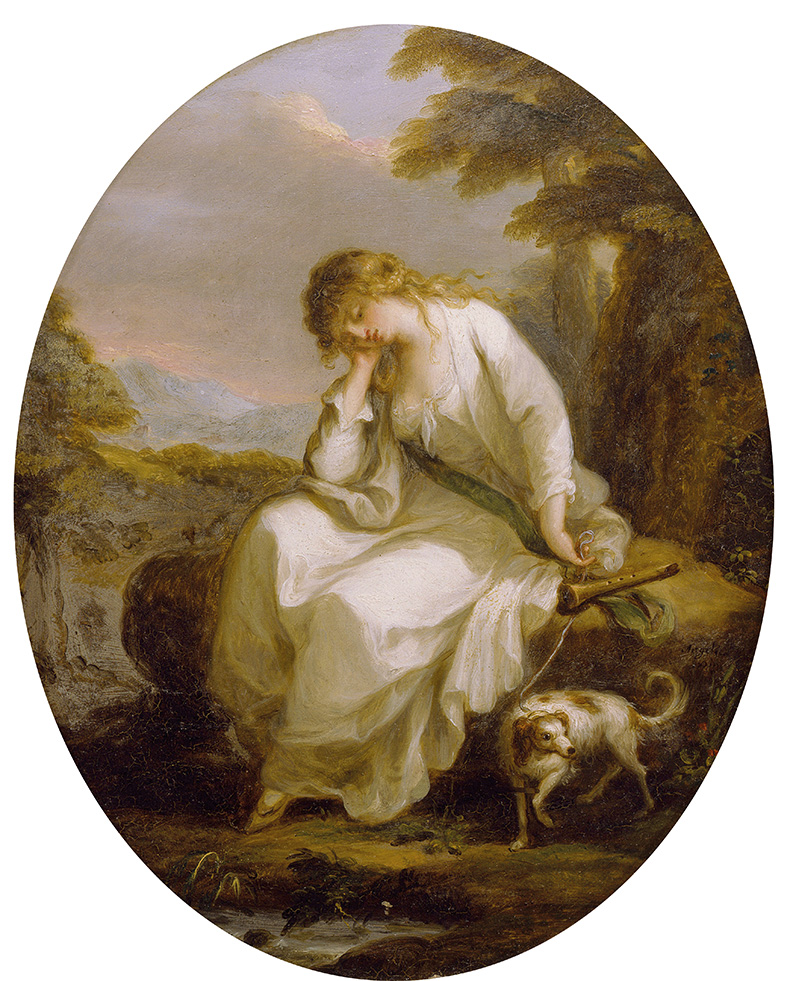
Poor Maria (1777), Angelica Kauffman. Burghley House, Stamford
In 1777, Kauffman painted Poor Maria, a single-figure history based on a famous episode from Sterne’s fiction. It was one of her most reproduced works, engraved and made into a decorative schema for objects such as watch cases, brooches and tea trays. Maria, known universally as ‘poor Maria’, appears in the final volume of Tristram Shandy (1767): she is a beautiful, distressed young woman whom Tristram encounters in northern France, ‘sitting upon a bank’, clutching a pet goat and playing mournfully on her pipe. Readers responded so fervently to her ‘sorrows’ that Sterne brought her back in A Sentimental Journey (1768). Yorick, the hero, an old friend of the Shandy family, makes a detour while on his travels to find her:
I discovered poor Maria sitting under a poplar. She was sitting with her elbow in her lap, and her head leaning on one side within her hand: — a small brook ran at the foot of the tree. […]
She was dress’d in white, and much as my friend described her, except that her hair hung loose, which before was twisted within a silk net. — She had superadded likewise to her jacket, a pale green riband, which fell across her shoulder to the waist; at the end of which hung her pipe. — Her goat had been as faithless as her lover; and she had got a little dog in lieu of him, which she had kept tied by a string to her girdle.
Sterne makes Maria a model subject for sentimental pity. Narrative happens, but it passes her by: through the years, she remains in the same spot, available to Tristram, available to Yorick, available to any stranger with a kind heart, barely changed from one novel to the next, save for a new ribbon and a different hairstyle. In Poor Maria, Kauffman realises Yorick’s vision of her. Maria leans her head on her hand, in the classic melancholic pose, her hair falling loose; a green ribbon bisects her white dress; in her fingers, she has a piece of string attached to her dog’s collar, gripping it firmly, as if anxious it will leave her like her ‘faithless’ goat. But a difference arises in the way we relate to her. Novels ask us to sympathise with pathetic figures by showing us other characters doing so. In A Sentimental Journey, we see Maria not directly, but through Yorick’s tearful eyes, which lead our gaze and instruct our emotional response. Kauffman’s composition has no other figure: there’s only Maria, alone, which means we are being asked and trusted to feel without being told how to.
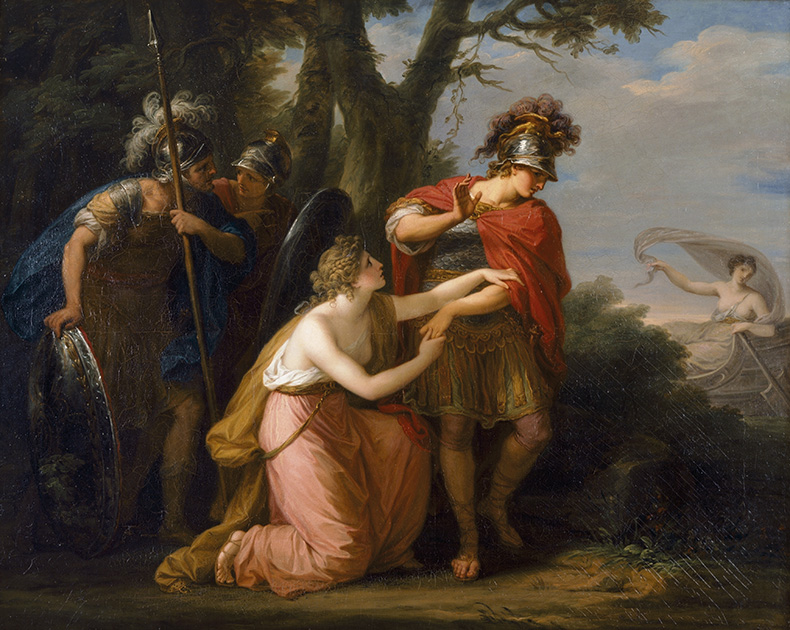
Armida Begs Rinaldo in Vain not to Leave Her (1776), Angelica Kauffman. Kenwood House, London. Photo: © English Heritage
Kauffman’s lonely women are tests of the sentimental imagination. Reading them means being able to project substance – Maria’s lost lover, Odysseus, Theseus, Mark Antony – into empty space, then mentally take it away again. But she also painted multi-figure sentimental histories, which show bodies interacting with one another, expressing shared sensibilities or opposing ones. Several depict crossroads moments, scenes in which characters can be seen hesitating between antithetical feelings and needs. ‘The emotionally moved Hector is not fully determined,’ the critic Helfrich Peter Sturz observed of Kauffman’s Hector Taking Leave of Andromache (1768), showing Hector on the brink of leaving for war but still clutching Andromache’s hand. ‘Will he remain? Or will he pull himself away? This indecision perturbs the soul and is the great principle of all painting for the heart.’
Kauffman portrayed such moments of ‘indecision’ in frieze-like compositions, ranging her characters side by side across the picture plane. Her Hector appears (almost literally) tugged both ways, pulled back to the left by Andromache’s hand on his shoulder, and to the right, symbolically, by the view out from the city gates to the wider world of the war. The two protagonists’ sharply differentiated bodies express emotional discord. Andromache, static, in profile, her face in shadow, gazes imploringly at her husband; Hector, facing the viewer, is captured already half in motion, his right shoulder poised to turn away. Armida Begs Rinaldo in Vain not to Leave Her (1776), a scene from Tasso’s epic poem La Gerusalemme liberata (1581), shows a more extreme mismatch of sympathies. Rinaldo, a Christian soldier, is pictured in the act of trying to shake off Armida, the beautiful sorceress who has bewitched him. Her face, upturned, pleading, contrasts with his downturned and shadowy one; her frozen position, on her knees on the ground, is set against the implied dynamism of his body, his right hand flapping in the air to fend her off, foot already lifted.
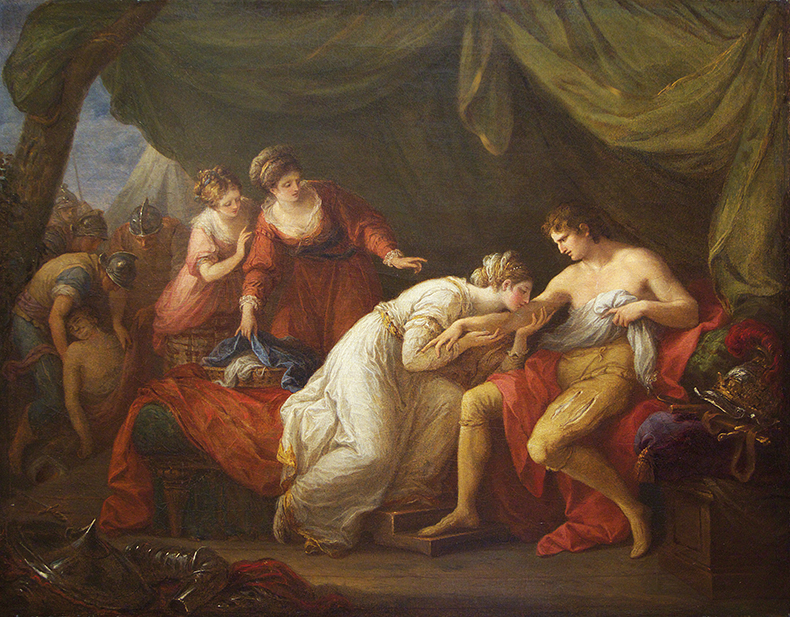
Eleanora Sucking the Venom Out of the Wound of Her Husband, King Edward I (1776), Angelica Kauffman. Private collection, Vorarlberg; courtesy Royal Academy of Arts, London
Kauffman’s most affirming histories show reciprocated touch, bodies in consonance. In Death of Alcestis (1790), depicting the moment Alcestis sacrifices herself to save her husband Admetus, the ideal bond between husband and wife is suggested by the interlocked bodies of the two protagonists – head overlaying head, the position of Admetus’s left arm echoing that of Alcestis’s right. Eleanora Sucking the Venom Out of the Wound of Her Husband, King Edward I (1776), a scene from the history of the Crusades, has its key bodies mirror one another. The king’s bent right knee touches the queen’s bent left; the angle of his other leg, drawn back, is mirrored by the angle of hers; the elegant line of her head, neck and shoulders, as she bends over his wounded arm, reproduces, in the opposite direction, the arm’s elongated curve. In A Treatise of Human Nature (1739), a foundational text for proponents of sensibility, David Hume had suggested that sympathy between individuals involved a kind of mirroring. To sympathise with another was to feel exactly as they felt, by the power of imaginative projection. Yorick wipes away Maria’s tears with his handkerchief, but immediately finds he needs it himself: ‘I then steep’d it in my own,—and then in hers,—and then in mine,—and then I wip’d hers again.’ Kauffman’s Eleanora illustrates what perfect sympathetic correspondence might look like, in the formal relationship between two bodies in space.
‘Angelica Kauffman’ is at the Royal Academy of Arts, London, from 1 March–30 June.
From the March 2024 issue of Apollo. Preview and subscribe here.
Unlimited access from just $16 every 3 months
Subscribe to get unlimited and exclusive access to the top art stories, interviews and exhibition reviews.

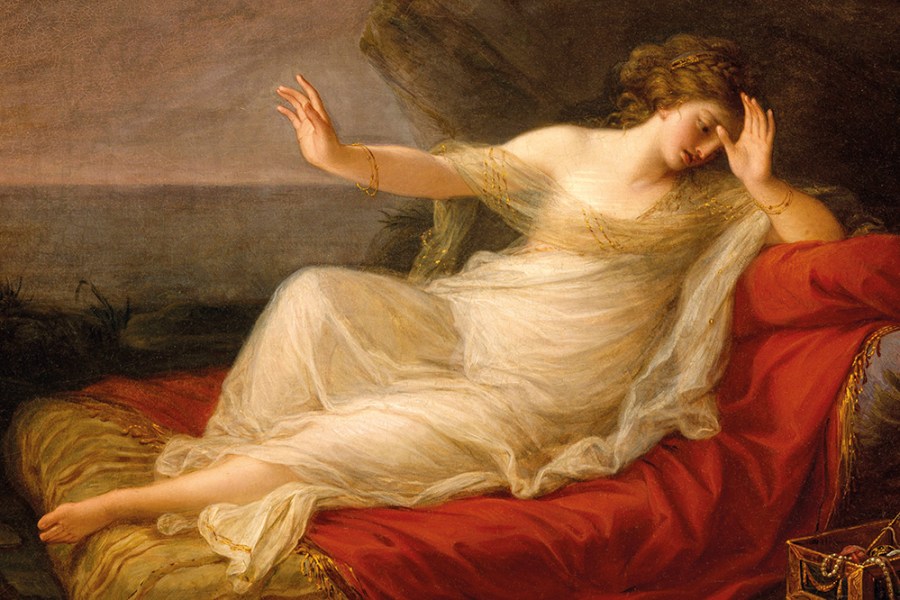
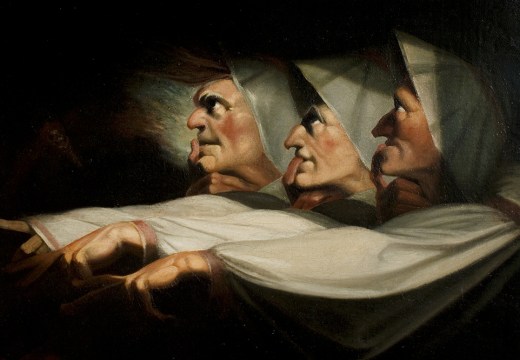
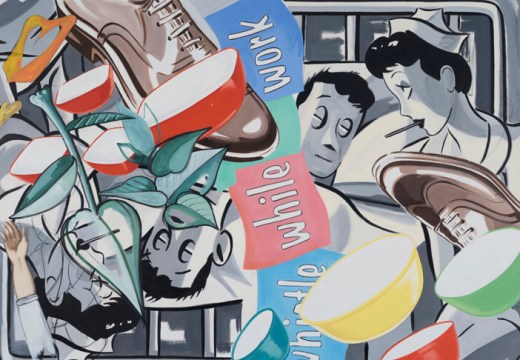
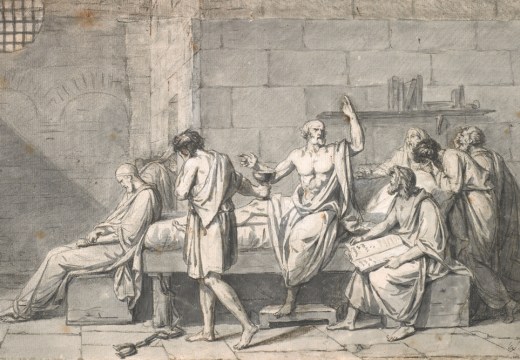








![Masterpiece [Re]discovery 2022. Photo: Ben Fisher Photography, courtesy of Masterpiece London](http://www.apollo-magazine.com/wp-content/uploads/2022/07/MPL2022_4263.jpg)
Are the art market’s problems being blown out of proportion?